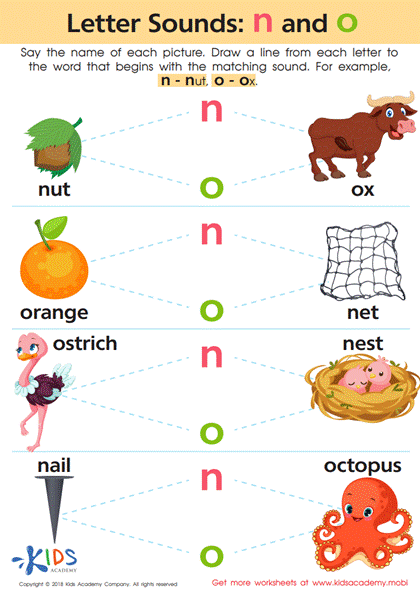-
English
-
English Pre-K
-
Unit 1: Early Literacy Skills
-
ABCs
- Pre-writing Activities
- Letter A
- Letter B
- Letter C
- Letter D
- Letter E
- Letter F
- Letter G
- Letter H
- Letter I
- Letter J
- Letter K
- Letter L
- Letter M
- Letter N
- Letter O
- Letter P
- Letter Q
- Letter R
- Letter S
- Letter T
- Letter U
- Letter V
- Letter W
- Letter X
- Letter Y
- Letter Z
-
Phonological Awareness
- Rhyming Words
- Letter Sounds B, C, D, and F
- Letter Sounds G, H, J, and K
- Letter Sounds L, M, N, and P
- Letter Sounds Q, R, S, and T
- Letter Sounds V, W, X, Y, and Z
- Letter Sounds A, E, and I
- Letter Sounds O and U
- Beginning Sounds
- Matching Letters to Sounds
-
ABCs
-
Unit 2: Vocabulary
-
Common Words
- Sorting Words into Categories
- Color Words
- Verbs and Adjectives
-
Sight Words
- Sight Words 'I' and 'Can'
- Sight Words 'You' and 'Like'
-
Common Words
-
Unit 3: Print Awareness
-
Parts of a Book
- Working with a Book
- Spaces Between Words
- Text and Illustrations
-
Picture Books and Poems
- Picture Book Text Features
- Poem Text Features
- Signs and Labels in the Community
-
Parts of a Book
-
Unit 4: Reading Literature
- Questions About Stories
- Discussing Stories
-
Unit 5: Reading Informational Texts
- Retelling Details in a Text
- Questions About a Text
- Connections Between Events
- Text Features
- Describing Illustrations
-
Unit 1: Early Literacy Skills
-
English Pre-K
-
Math
-
Math for Pre-Kindergarten
-
Logic and Geometry
-
Matching and Sorting
- Same and Different
- Which One Is a Little Different?
- Objects That Go Together
- Sorting by Color and Size
- Sorting The Same Group in Different Ways
- Patterns
-
Shapes
- Shapes in Our Environment
- Naming Shapes Regardless of Size
- Making Shapes in Preschool
- Comparing Shapes
- Relative Positions
- Sorting Shapes
-
Matching and Sorting
-
Early Number Sense
-
Numbers 1–5
- Counting to 3
- Counting to 5
- Arranging Objects up to 3 Objects
- Arranging up to 5 Objects
- Writing Numbers 1–5
-
Numbers 1–5
-
Numbers up to 10
- Counting to 10
- Arranging up to 10 Objects
- Number 0
- Writing Numbers 6–10
- Breaking Down Numbers 6-10
-
Logic and Geometry
-
Math for Pre-Kindergarten
Teaching Letter Sounds O and U to a Preschooler
Phonological awareness is the ability to recognize, identify and manipulate sounds from the phoneme level to the sentence level. This skill is the main determiner for your child’s future reading and writing skills. Learning vowels is essential for the development of phonological awareness skills. Now that your child has learned the first three vowels, you can move on to the remaining two: O and U.
Letter Sound O
At the beginning of words, the letter O produces the short /ŏ/ sound. To help your child learn this letter sound, offer them opportunities to practice it through activities and worksheets. One game you can play is print out 10 images of random objects and animals, 5 of which start with the letter O. For example: cat, oven, bear, olive, boy, leaf, ostrich, hat, orange, ball, ogre. Have your child name the object in each image, then identify the ones that start with the /ŏ/ sound, and glue them onto a sheet of paper to make a collage.
You can also print out this Kids Academy worksheet titled “Letter Sounds: N and O” to help them practice their /n/ and /ŏ/ sounds as well as their fine motor skills through tracing the line from the image to its corresponding letter sound.
Letter Sound U
One sound the letter U makes is the short /ŭ/ sound, like in the word “up”. This is the first letter U sound we teach at the preschool level. One reason this sounds is a bit tricky is because it resembles the letter sound A. To help your child practice how to differentiate these two letter sounds, set up an activity where they need to distinguish between the two. For example, divide a whiteboard into two columns, one for the letter sound A and the other one for U. Print out images of the following word pairs: cup/cap, bug/bag, mud/mad, and have them try to identify which of each pair is the one with the /ă/ sound, and which is the one with the /ŭ/ and sort them accordingly. Alternatively, you can choose random words for each of the two letters instead of using word pairs. You can use words such as ant, pan, mat, fan, and bat for the letter A, and cup, duck, bug, mug, and bun for the letter U.
To further practice their letter-sound U, offer your child this Kids Academy “Letter Sound: U” worksheet, where they have to circle the images that have the /ŭ/ in them.
Use the following activity to help your child revise the newly acquired knowledge from our lesson: prepare a big bag of small colorful balls, and place two buckets on the floor, one for the letter sound O, and one for U. As you sound out the letters O and U, have your child put a ball in the corresponding bucket. This activity can also act as an assessment to the lesson, in addition to being great physical exercise for your child! Use our interactive catalogue to find more articles on different aspects of phonological awareness.



